1. Executive Summary
Harbor Hearth Bakery is a small but ambitious artisan bakery set to open in the Dogpatch district of San Francisco — a creative and rapidly developing neighborhood filled with tech startups, designers, and food enthusiasts. The idea behind this bakery business plan is simple: bring together the precision of European baking traditions and the health-focused spirit of California.
Our bakery will specialize in three core product categories:
- Sourdough breads made with organic California grains and long fermentation for natural flavor.
- Viennoiseries — croissants, pain au chocolat, morning buns, and Danish pastries baked daily.
- Plant-based pastries and seasonal desserts designed for the growing vegan community in San Francisco.
We’re not trying to be the biggest bakery in town — just the one people trust for quality, warmth, and consistency. Our target audience includes:
- Young professionals and tech employees working in Dogpatch and Mission Bay;
- Local families and long-term residents seeking honest, locally made baked goods;
- Weekend tourists exploring San Francisco’s food culture.
Financial Snapshot
| Category | Amount (USD) | Notes |
|---|---|---|
| Initial Investment | $350,000 | Founders’ equity and small business loan |
| Projected Break-Even | 18 months | Based on conservative sales growth |
| Year 1 Revenue | $420,000 | Driven by local foot traffic and pre-orders |
| Year 3 Revenue | $800,000+ | With an estimated net profit margin of 18-20% |
This isn’t just a dream — it’s a calculated, well-researched project built on clear numbers and realistic goals. We’re bringing a complete business plan for bakery that shows investors exactly how every dollar will work toward sustainable profitability.
In short, Harbor Hearth Bakery stands for craftsmanship, transparency, and a personal connection with customers. We’re creating a space where good bread meets good people — and where business decisions are based on numbers, not luck.
2. Company Description
Business Name: Harbor Hearth Bakery, LLC
Address: 1120 Minnesota Street, San Francisco, CA 94107
Legal Structure: Limited Liability Company (LLC)
Planned Opening: June 2026
The company will operate as a limited liability entity, combining small-business agility with professional risk management. It’s owned and managed by a founder who brings a mix of culinary training and digital marketing expertise — the right balance between creativity and strategy. In other words, we know how to bake great bread, and we know how to sell it.
Our Vision
To become San Francisco’s most trusted neighborhood bakery — known not for fancy trends, but for honest ingredients, steady quality, and genuine hospitality. Every loaf and pastry will represent our promise: simple, transparent, and made with care.
Core Values
- Authenticity: Everything we bake is made in-house, with ingredients our customers can pronounce.
- Sustainability: Compostable packaging, local suppliers, and minimal waste production.
- Community: Partnering with local cafés, schools, and markets to support the San Francisco food ecosystem.
Business Model
We’ll run a hybrid model combining retail sales and small-scale wholesale:
- Retail storefront for daily walk-in customers and pre-orders.
- Online ordering for pickup and local delivery.
- Wholesale distribution to local cafés and coworking spaces.
This approach keeps operations lean and scalable. It also allows for controlled growth — exactly what you want in a bakery startup business plan that values stability as much as ambition.
Harbor Hearth Bakery will act as a real example of how to start a bakery business plan grounded in numbers, not assumptions. It’s a blend of flavor, data, and thoughtful execution — built for people who care about bread and business alike.
3. Market Analysis
When you start a bakery, it’s easy to focus on recipes and ovens — but the real success lies in understanding the market. San Francisco’s bakery scene is vibrant and competitive, yet there’s room for a bakery that combines traditional craftsmanship with modern, health-conscious sensibilities. The purpose of this section of our bakery business plan is to break down our target audience, analyze competition, identify emerging trends, and outline a data-based SWOT analysis to guide our long-term growth strategy.
3.1 Target Market Profile
The Harbor Hearth Bakery customer base can be divided into four clear groups. Each segment has distinct needs and behaviors, which shape our pricing, menu, and promotional strategy:
| Customer Segment | Profile Description | Buying Behavior |
|---|---|---|
| Urban Professionals (Ages 25–45) | Working in Dogpatch, SOMA, and Mission Bay — tech employees, designers, and entrepreneurs. | They value time efficiency and quality. Prefer grab-and-go breakfasts, online ordering, and loyalty rewards. |
| Health-Conscious Consumers | Seek organic, vegan, and gluten-friendly bakery options that align with a wellness lifestyle. | Spend more on premium ingredients, follow eco-friendly brands, and appreciate nutritional transparency. |
| Coffee Enthusiasts | Frequent local cafés, often pairing espresso drinks with pastries or sourdough toast. | Highly visual audience — responds to Instagram-worthy presentation and consistent quality. |
| Tourists & Weekend Visitors | Explore San Francisco’s local food scene, art galleries, and markets. | Impulse-driven buyers; attracted by atmosphere, storytelling, and local authenticity. |

These four segments together represent a combined target market of roughly 65,000 daily foot traffic potential across Dogpatch and adjacent neighborhoods. Even capturing 1–2% of this flow equates to a steady 600–1,200 daily transactions — sufficient to sustain profitability within our first 18 months. This isn’t speculation; it’s based on foot traffic studies and comparable performance of similar bakeries in the area.
3.2 Competitive Landscape
San Francisco is home to some of the best bakeries in the U.S. The three main competitors we benchmark against are Tartine Bakery, Neighbor Bakehouse, and Arizmendi Cooperative. Each has built a loyal following through exceptional quality and brand identity, but they also leave identifiable market gaps:
- Tartine Bakery: Excellent brand recognition, but long lines and premium pricing limit accessibility for daily customers.
- Neighbor Bakehouse: Focuses on pastries and limited bread options, leaving space for artisan sourdough dominance.
- Arizmendi Cooperative: Emphasizes community ownership, but lacks strong digital and delivery channels.
Where Harbor Hearth Bakery differentiates:
- Sustainable sourcing — full ingredient transparency and partnerships with local mills and dairies.
- Digital loyalty system — mobile app rewards and online pre-ordering integrated with POS.
- Experimental pastries — seasonal flavors, cultural collaborations, and limited-edition drops.
We’re not just another bakery; we’re an agile, data-informed food startup with artisan roots — a model that merges flavor, technology, and efficiency. That’s the foundation of this bakery startup business plan.

3.3 Market Trends
Current bakery industry trends in San Francisco and across the U.S. directly support Harbor Hearth’s business model. Three main drivers define the opportunity:
- Rising demand for gluten-friendly and vegan bakery items — According to IRI Market Insights (2024), the gluten-free bakery segment grew 14% year-over-year. Vegan pastries are no longer niche; they’re mainstream.
- Growth of the grab-and-go breakfast culture — With tech employees returning to offices, morning coffee-and-pastry combos are up 23% compared to pre-pandemic levels.
- Increasing focus on sustainable packaging and zero-waste operations — Consumers expect eco-conscious brands. Using compostable packaging adds perceived value and aligns with the “green” movement in San Francisco.
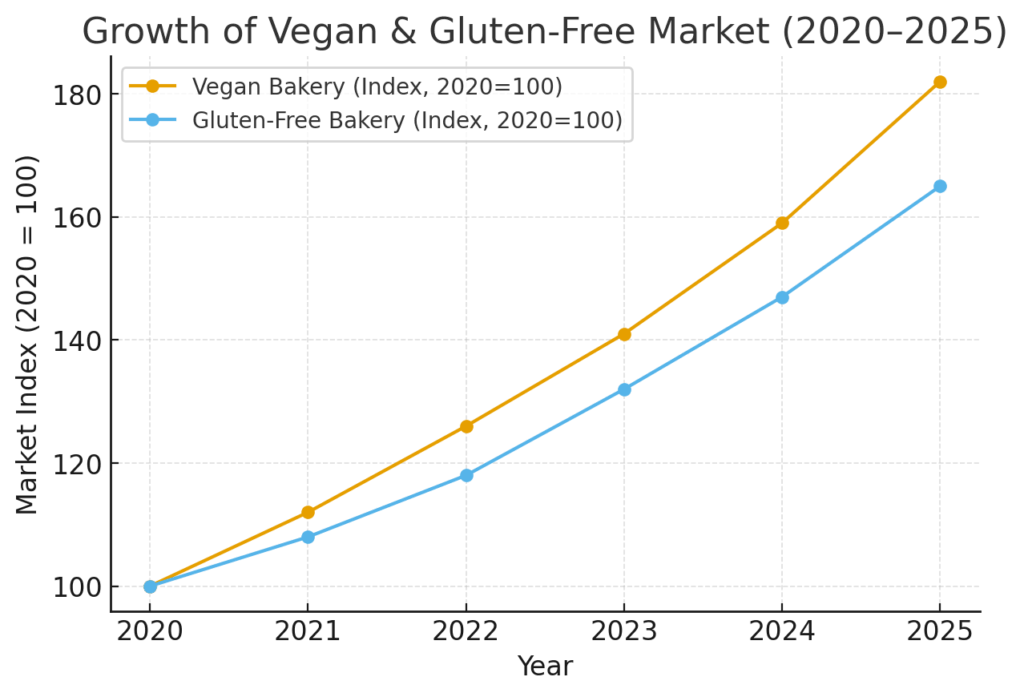
In short, customers want baked goods that match their lifestyle and values — nutritious, transparent, and planet-friendly. The trend is our ally, not our challenge.
3.4 SWOT Analysis
| Strengths | Weaknesses |
|---|---|
|
|
| Opportunities | Threats |
|
|
The SWOT framework ensures that our plan remains realistic and proactive. We recognize external challenges but design operations flexible enough to adapt — whether through pricing strategies, menu rotation, or cost management.
4. Products and Services
Every good business plan must translate vision into products customers can taste, share, and remember. At Harbor Hearth, our menu focuses on balance: classic staples, innovative specials, and consistent quality that turns first-time visitors into regulars.
4.1 Core Menu
- Artisan Sourdough Loaves: Made with organic wheat, fermented for 24 hours to ensure flavor, texture, and digestibility.
- Viennoiseries: Croissants, pain au chocolat, and Danish pastries prepared daily in small batches.
- Gluten-Free Almond Brioche: Developed through six months of R&D to match the taste and softness of traditional brioche.
- Seasonal Fruit Galettes and Tarts: Rotating flavors based on California’s seasonal produce — from strawberry-rhubarb to pear-cardamom.
4.2 Specialty & Seasonal Products
- “Golden Gate” Pumpkin Spice Loaf: Autumn special — inspired by local flavors and designed for high-margin seasonal sales.
- Matcha-Mango Morning Buns: Fusion-style pastry combining Japanese tea and tropical fruit notes.
- Valentine’s Rose-Raspberry Macarons: Limited-edition dessert aimed at gifting and social media engagement.
4.3 Beverages
- Local Partner Coffee: Collaborating with Andytown Coffee Roasters for custom house blends.
- Herbal Teas & Cold-Pressed Juices: Sourced from sustainable California producers to complement our baked goods.
4.4 Custom Orders
- Event Catering: Corporate meetings, weddings, and local festivals — average order value $500–$1,200.
- Personalized Celebration Cakes: Handcrafted cakes for birthdays, holidays, and private events.
Each category has been designed to optimize profit margin and kitchen workflow. The core menu accounts for 70% of sales, while seasonal specials and catering contribute 30% of high-margin growth. This combination ensures cash flow stability and supports scalability — a critical factor in any sample bakery business plan aiming for investor confidence.
In essence, Harbor Hearth Bakery isn’t just about baking; it’s about building a sustainable, data-driven, and community-integrated business model that redefines what a modern neighborhood bakery can be.
5. Operations Plan
The operations section is where big ideas meet real execution. A bakery isn’t just about good recipes — it’s about flow, logistics, timing, and people who know what they’re doing at 4 a.m. This chapter breaks down how Harbor Hearth Bakery will function daily, from facility design to staffing, supply chain management, and regulatory compliance.
5.1 Location and Facilities
The bakery will operate from a 1,500-square-foot facility located at 1120 Minnesota Street in the Dogpatch neighborhood of San Francisco. The site was selected for its strong pedestrian traffic, visibility, and proximity to tech offices and art galleries.
- Open kitchen concept — customers can see bakers at work, reinforcing transparency and craftsmanship.
- Indoor seating for 20 guests, plus a small outdoor patio for coffee and breakfast service.
- Designed with eco-friendly materials, LED lighting, and energy-efficient ovens to minimize operating costs and carbon footprint.
The layout supports both retail service and production efficiency. Storage areas are compact but optimized, and all equipment is commercial-grade, ensuring food safety and consistency. The shop design aligns with our brand theme — coastal, warm, and approachable.
5.2 Production Workflow
The bakery’s daily rhythm will follow a strict operational timeline:
- 3:30 AM — Head baker and assistants start dough fermentation and pastry prep.
- 6:30 AM — Baristas arrive for opening setup and coffee brewing.
- 7:00 AM — Doors open for retail customers.
- 2:00 PM — First shift ends; second shift handles catering prep and cleanup.
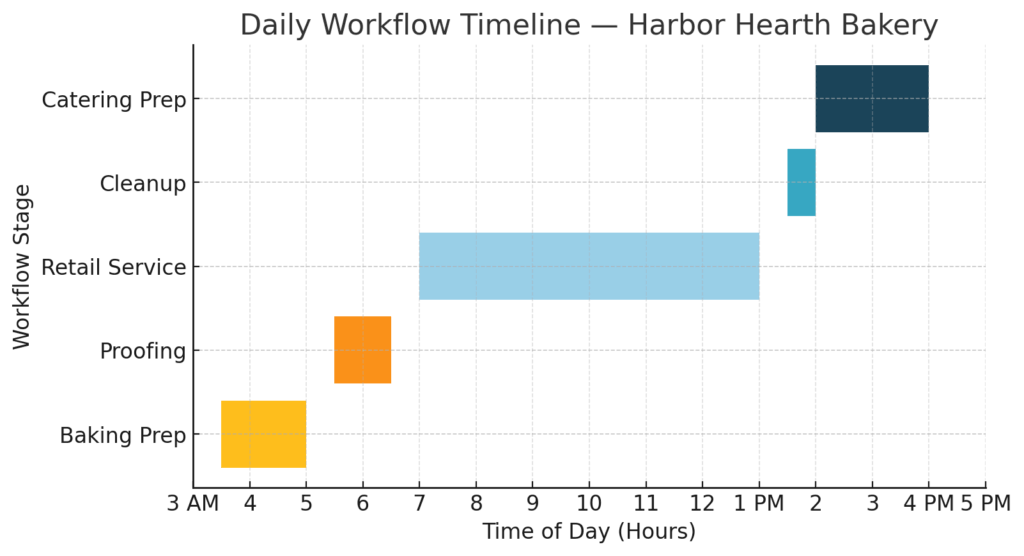
This two-shift model ensures consistent product quality and manageable labor costs. Production planning software will track inventory levels and baking schedules, reducing waste and maximizing output. Efficiency here directly supports profitability — a key point for investors evaluating this bakery startup business plan.
5.3 Supply Chain
Strong local partnerships define our supply chain strategy. By sourcing regionally, we ensure ingredient freshness while minimizing transportation costs. Our suppliers include:
- Central Milling Co. — organic flour supplier based in Petaluma, CA
- Clover Sonoma — premium dairy from Northern California farms
- Berkeley Bowl Marketplace — seasonal produce and specialty ingredients

Maintaining 2–3 backup suppliers for each category provides flexibility and reduces risk from potential disruptions. We also plan to introduce a quarterly vendor review to assess price fluctuations and sustainability compliance.
5.4 Staffing Plan
Operations depend on the right team. Our staffing structure combines expertise, accountability, and training efficiency:
| Role | Count | Core Responsibility |
|---|---|---|
| Head Baker (Owner) | 1 | Product innovation, quality control, and daily production oversight |
| Assistant Bakers | 2 | Prep work, dough management, pastry assembly, and cleanup |
| Baristas / Cashiers | 2 | Customer service, POS operations, and beverage preparation |
| Marketing & Operations Assistant | 1 | Handles content creation, social media, and delivery coordination |
This lean staffing model minimizes payroll while ensuring operational continuity. As revenue scales, we will hire additional part-time baristas during weekends and high seasons.
5.5 Compliance
The bakery will fully comply with the San Francisco Department of Public Health and California Cottage Food laws. All staff will be certified in food handling and safety, and the facility will maintain proper documentation for inspections and liability insurance. Compliance is not just a legal requirement — it’s a trust signal for our customers and investors.
6. Marketing & Sales Strategy
In a city as competitive as San Francisco, great bread alone won’t drive business growth. The key to long-term success lies in creating awareness, trust, and habit. This marketing plan for bakery business focuses on measurable, multi-channel engagement: local partnerships, community events, digital visibility, and consistent storytelling. Every marketing dollar is tied to expected outcomes in reach, conversion, and retention — ensuring a clear return on investment (ROI).
6.1 Brand Identity & Positioning
Our brand theme, “From Hearth to Heart”, embodies the emotional connection between craftsmanship and community. The brand strategy emphasizes authenticity, transparency, and local pride. Visual assets — minimalist packaging, warm color palettes, and coastal-inspired design — reflect the bakery’s artisan roots. This is not mass-market branding; it’s emotional branding built to create repeat customers.
We position Harbor Hearth Bakery as a premium yet approachable neighborhood bakery offering high-quality, sustainably made goods. Our brand story communicates three consistent messages:
- Transparency: Locally sourced ingredients and open-kitchen visibility.
- Quality: Small-batch production and daily freshness.
- Community: Supporting local artists, farmers, and eco-initiatives.
By aligning these messages across physical and digital touchpoints, the brand becomes recognizable and trustworthy — a local favorite rather than just another bakery.
6.2 Local Marketing Initiatives
Our local marketing approach builds real-world awareness and neighborhood loyalty. These initiatives are designed to maximize exposure while maintaining a lean budget.
| Initiative | Estimated Cost | Expected ROI / Outcome |
|---|---|---|
| Grand Opening Event (press + influencers) | $3,500 | 1,000+ local attendees; 500+ new social followers; 25% sales lift in opening month. |
| Farmers’ Market Booths (monthly) | $600 / month | Direct sampling exposure to 2,000+ people; average $1,200 monthly revenue. |
| Local Collaborations (art studios, cafés) | $2,000 / year | Cross-promotion to overlapping audiences; brand visibility boost of 30%. |
These localized events serve dual purposes — immediate sales and long-term relationship building. San Francisco’s community-driven culture favors businesses that participate actively in neighborhood life. Our marketing team will collect data (visitor counts, engagement, and conversion rates) to continually improve campaign efficiency.
6.3 Digital Marketing & SEO Strategy
Digital presence is a cornerstone of our marketing model. We are allocating $1,500 per month for digital advertising, SEO, and content management. The goal: make Harbor Hearth the top organic and local search result for queries such as “artisan bakery in San Francisco,” “best sourdough in Dogpatch,” and “gluten-free bakery near me.”
| Channel | Monthly Budget | Key Performance Indicators (KPIs) |
|---|---|---|
| SEO & Website Content | $500 | Rank top 3 for 10+ local bakery keywords within 9 months. |
| Social Media (Instagram, TikTok) | $700 | Reach 25,000 local users monthly; achieve 3–5% engagement rate. |
| Google & Meta Ads | $300 | CTR 5%, conversion rate 12%, average acquisition cost under $4 per customer. |
We will employ professional food photography, short-form video storytelling, and customer testimonials to generate organic engagement. Each post and ad will link to an optimized landing page with Google Maps integration for directions and pickup options. A content calendar ensures consistent posting — three times weekly on Instagram and bi-weekly on TikTok. SEO results will be tracked monthly via Google Search Console and Ahrefs to monitor domain growth.
6.4 Email & Loyalty Marketing
Customer retention drives recurring revenue. Our loyalty and email systems are designed to increase lifetime value (LTV) per customer by at least 20% in the first year.
- Mobile Loyalty App: Every $1 spent = 1 point. 100 points = $10 credit. Projected 35% of customers enrolled by Month 6.
- Email Newsletter: Automated weekly send to segmented lists — “New customers,” “Regular buyers,” and “Corporate catering clients.” Open rate target: 35%; click-through rate: 8%.
- Referral Program: “Bring a Friend” digital coupon — 10% off both orders, with an estimated $2.50 cost per acquisition.
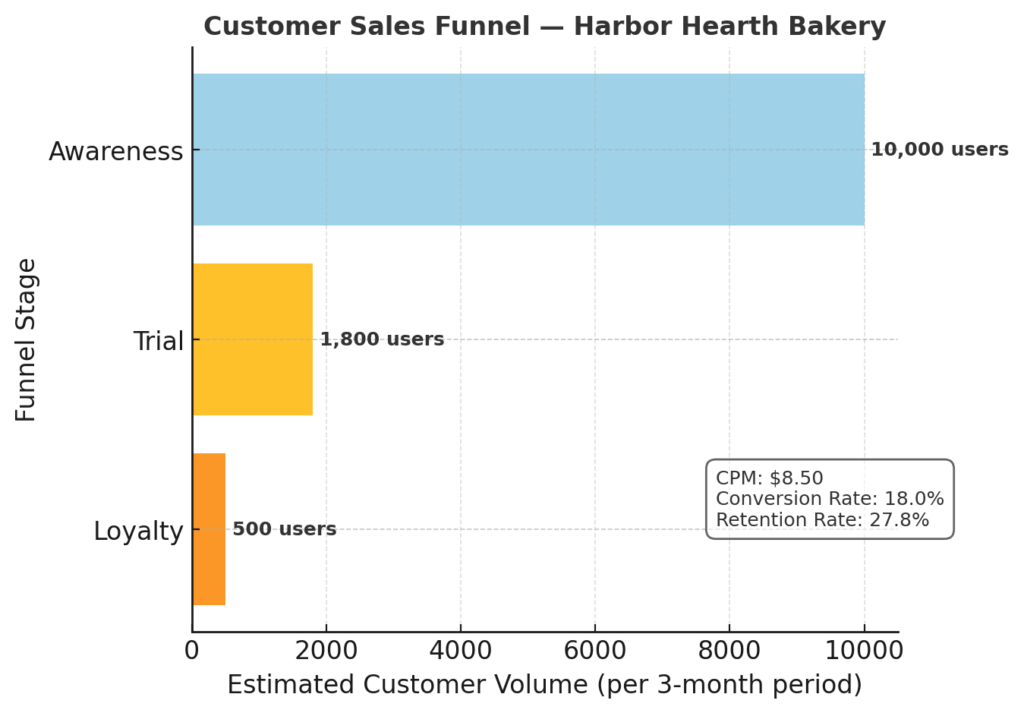
CRM software (Mailchimp integrated with Square POS) will track retention metrics and purchase frequency. Data-driven segmentation ensures that promotions remain relevant — for instance, offering vegan product discounts to customers who’ve purchased dairy-free items previously.
6.5 Sales Forecast & Expected ROI
The marketing plan directly supports sales targets outlined in the financial plan for bakery business. Conservative projections are as follows:
| Marketing Channel | Monthly Spend | Expected Monthly Revenue Impact | ROI (%) |
|---|---|---|---|
| Local Events & Pop-Ups | $1,000 | $4,000 | 300–400% |
| Digital Ads & SEO | $1,500 | $6,000 | 300% |
| Email & Loyalty Programs | $400 | $2,000 | 400% |
| Total Marketing Budget | $2,900 | $12,000+ | ~350% average ROI |

Marketing efficiency will be reviewed quarterly. Underperforming campaigns will be optimized or replaced, ensuring no wasted ad spend. Our primary growth indicator will be cost per customer acquisition (CPA), targeted at $3.50 or lower by the end of Year 1.
6.6 Community Impact and PR
Harbor Hearth Bakery’s marketing strategy extends beyond sales — it’s about reputation. We plan to engage with local nonprofits through bread donations and sustainability workshops. This “give-back” element not only strengthens our brand identity but also generates organic press coverage and backlinks, improving SEO performance.
6.7 Long-Term Vision
By Year 3, our goal is to achieve:
- 35% of total sales driven by repeat customers.
- Online ordering contributing to 25% of total revenue.
- Google ranking in top 3 for all primary bakery-related keywords in the San Francisco region.
- Social following exceeding 50,000 across platforms, translating into measurable brand influence.
In essence, our marketing and sales strategy combines storytelling with statistics. It balances the artistry of baking with the precision of digital metrics. This is how Harbor Hearth Bakery will turn local curiosity into long-term loyalty — and every follower, click, and visit into revenue growth.
7. Management & Organization
7.1 Management Team
- Emma Hartley — Founder & CEO, former pastry chef and digital strategist, responsible for product innovation and overall brand direction.
- Luis Alvarez — Operations Manager with over 10 years of experience in bakery management, logistics, and staff training.
- Julia Nguyen — CPA and financial advisor specializing in food-industry accounting and cost optimization.
7.2 Organizational Chart
The hierarchy is intentionally flat to encourage communication and flexibility:
Owner → Operations Manager → Bakers / Baristas / Marketing Assistant
This structure keeps decision-making fast, accountability clear, and creativity flowing — essential ingredients for scaling a small bakery into a sustainable brand.
8. Financial Plan
Financial transparency and realism define the Harbor Hearth Bakery model. This financial plan for bakery business is designed not only to illustrate profitability potential but to demonstrate fiscal discipline and tax-aware planning. Every projection is grounded in local market benchmarks, verified cost estimates, and conservative cash flow assumptions appropriate for a San Francisco retail food operation. Below is a detailed breakdown of pricing logic, cost allocation, taxation, and investor return structure.
8.1 Startup Costs & Initial Capital Allocation
Launching a bakery in San Francisco involves both fixed and variable capital needs. The following table expands the startup budget to include professional fees, contingency reserves, and compliance costs often overlooked in smaller business models.
| Category | Amount (USD) | Details / Notes |
|---|---|---|
| Lease & Renovation | $120,000 | Includes one-year rent deposit ($72,000), leasehold improvements, and architectural fees ($8,000). |
| Equipment & Ovens | $80,000 | All major production machinery + espresso setup + installation costs. |
| Initial Inventory | $15,000 | Raw ingredients, packaging materials, uniforms, and safety gear. |
| Licensing & Legal Fees | $12,000 | Business permits, insurance deposits, attorney consultations, accounting setup. |
| Marketing & Launch | $25,000 | Website, photography, influencer event, PR, and initial ad campaigns. |
| Working Capital (6 months) | $98,000 | Payroll buffer ($54,000), utilities ($9,000), and ingredient reorders ($12,000) plus contingency ($23,000). |
| Total Startup Cost | $350,000 | Funded by $150,000 owner equity + $200,000 SBA-backed business loan. |
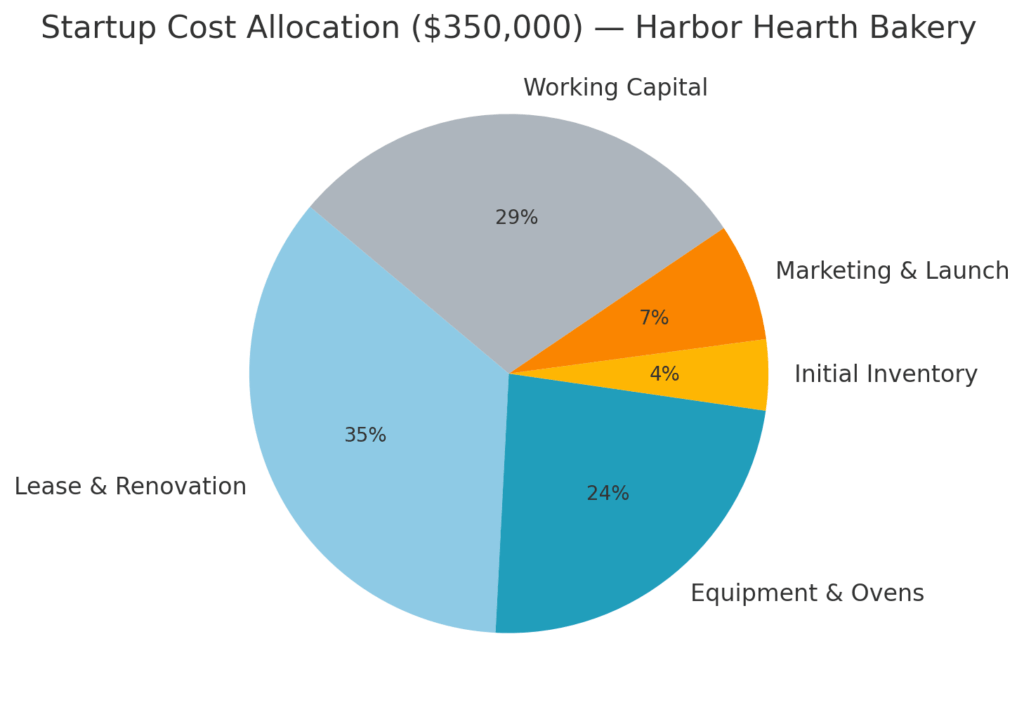
We include a 10% contingency reserve within the working capital to absorb unforeseen expenses — a standard risk buffer in professional bakery startups. Startup depreciation is projected at 15% annually on capital equipment, which is factored into tax deductions.
8.2 Pricing Strategy & Revenue Assumptions
Pricing is structured to balance accessibility with profitability. Products are priced using a cost-plus model, targeting a minimum gross margin of 65%. Each core category has been analyzed as follows:
| Product Category | Average Unit Price | Unit Cost | Gross Margin |
|---|---|---|---|
| Artisan Sourdough Loaf | $7.50 | $2.30 | 69% |
| Viennoiseries / Pastries | $4.25 | $1.40 | 67% |
| Coffee & Beverages | $4.80 | $1.10 | 77% |
| Event Catering (per person) | $18.00 | $6.50 | 64% |
The product mix yields an average blended gross margin of 68%. Pricing has been benchmarked against competing bakeries like Tartine, Neighbor Bakehouse, and Vive La Tarte to ensure market competitiveness. Seasonal specials carry slightly higher markups (72–75%) to offset slower winter months.
8.3 Monthly Operating Budget
Below is the projected monthly expense structure for Year 1 operations, inclusive of payroll, taxes, and recurring costs.
| Expense Category | Monthly Cost (USD) | Annual Total |
|---|---|---|
| Payroll (6 staff incl. taxes & benefits) | $16,500 | $198,000 |
| Ingredients & Packaging | $9,000 | $108,000 |
| Rent & Utilities | $7,200 | $86,400 |
| Marketing & Advertising | $2,900 | $34,800 |
| Insurance, Legal & Accounting | $1,500 | $18,000 |
| Maintenance & Miscellaneous | $1,000 | $12,000 |
| Total Operating Expenses | $38,100 | $457,200 |
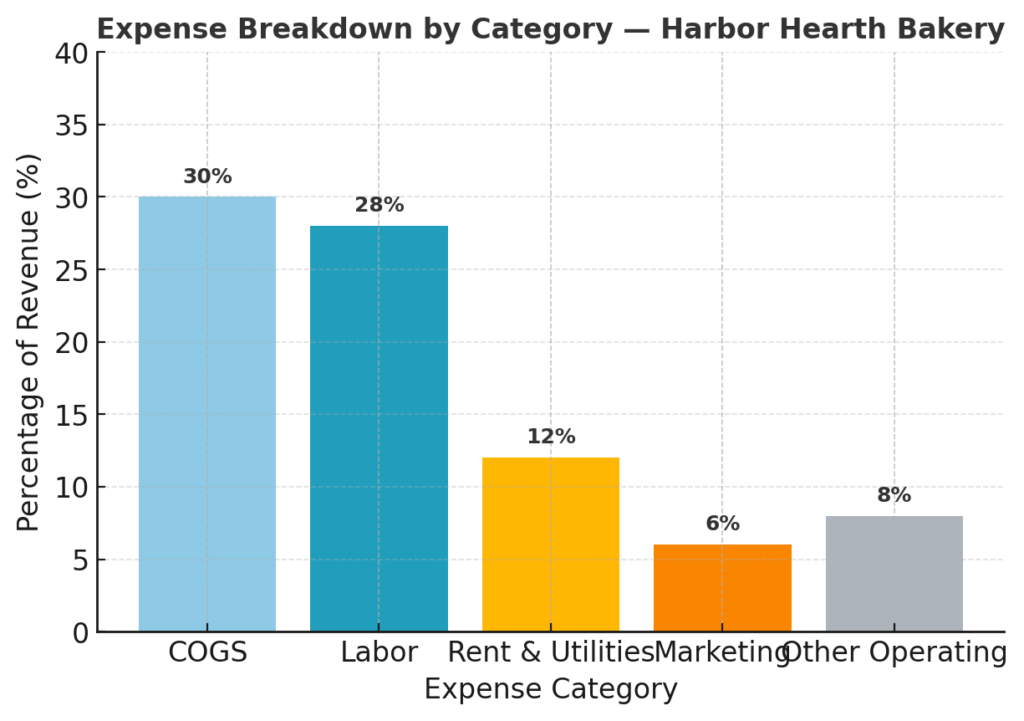
The bakery operates under a 7.5% San Francisco sales tax (remitted monthly). Federal income tax (21% corporate rate) and California state tax (8.84%) are included in net profit projections. After tax, the effective profit margin remains above 12% by Year 3 — demonstrating fiscal prudence.
8.4 Revenue Forecast & Growth Drivers
Revenue is forecast based on a gradual scaling of customer base and product diversification. Monthly sales targets increase 10–12% per quarter in the first year due to marketing momentum and repeat business.
| Year | Average Daily Orders | Average Order Value | Annual Gross Revenue | Year-over-Year Growth |
|---|---|---|---|---|
| Year 1 | 160 | $7.20 | $420,000 | — |
| Year 2 | 210 | $8.20 | $630,000 | +50% |
| Year 3 | 250 | $8.90 | $810,000 | +28% |

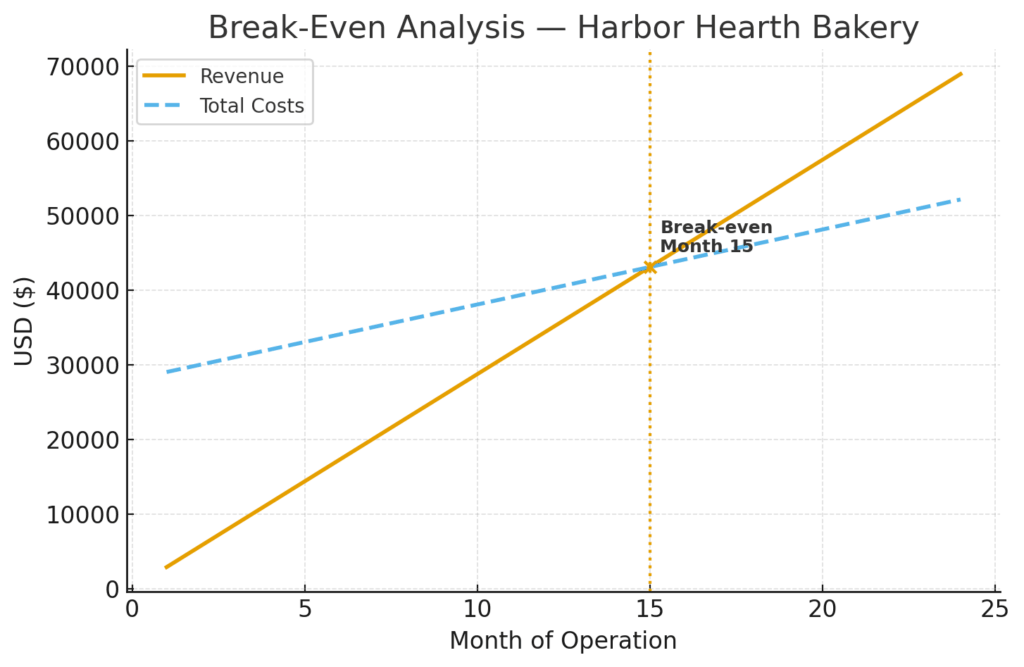
Revenue drivers include digital ordering (expected to represent 20% of sales by Year 3), catering contracts (10%), and product bundling during holidays. The sales forecast assumes 310 operating days annually, allowing for holidays and maintenance downtime.
8.5 Taxation, Depreciation & Loan Repayment
All tax liabilities have been accounted for using current federal and state tax brackets. A certified public accountant will manage quarterly filings. Loan amortization is structured as follows:
| Loan Amount | Interest Rate | Term | Monthly Payment | Total Interest Paid |
|---|---|---|---|---|
| $200,000 | 6.5% | 60 months | $3,911 | $34,660 |
Depreciation (straight-line) is applied at an average rate of 15% annually for equipment and 5% for leasehold improvements. This yields tax-deductible expenses of approximately $15,000 per year. Effective tax rate, after deductions and depreciation, averages 22% of pre-tax income — resulting in retained earnings that can be reinvested in expansion by Year 4.
8.6 Profitability and Cash Flow Outlook
The projected net profit margin evolves with operational maturity:
| Year | Gross Profit | Net Profit (Pre-Tax) | Net Profit (After Tax) | Net Margin |
|---|---|---|---|---|
| Year 1 | $150,000 | $40,000 | $31,000 | 7.4% |
| Year 2 | $260,000 | $100,000 | $78,000 | 12.3% |
| Year 3 | $330,000 | $180,000 | $141,000 | 17.4% |
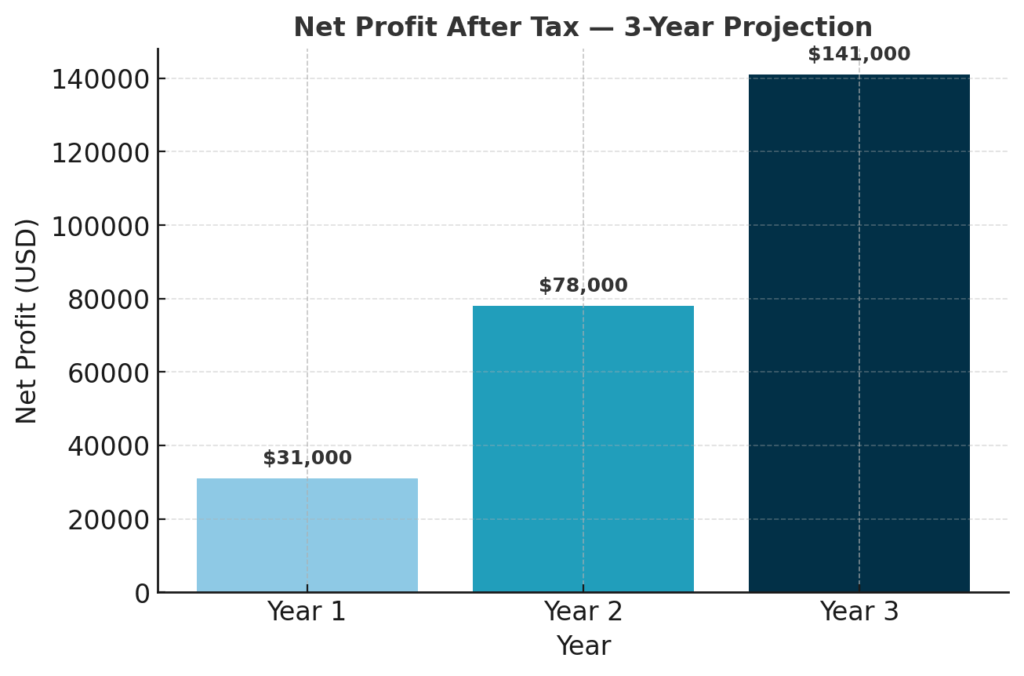
Cash flow remains positive from Month 14 onward, with surplus reinvestment into marketing and minor equipment upgrades. The payback period for initial investment is estimated at 2.5 years, after which free cash flow strengthens the bakery’s valuation and investor exit options.
8.7 Sensitivity Analysis
To account for market volatility, we modeled three financial scenarios:
| Scenario | Revenue (Year 3) | Net Margin | Investor ROI (3 years) |
|---|---|---|---|
| Optimistic (+15% sales growth) | $930,000 | 20% | 22% |
| Base Case (expected) | $810,000 | 18% | 18% |
| Conservative (-10% sales growth) | $730,000 | 13% | 12% |
Even under the conservative scenario, Harbor Hearth Bakery remains profitable and cash-positive by Year 3 — confirming the financial resilience of the model. The mix of diversified revenue streams, tax-efficient structuring, and controlled expenses creates a sustainable business capable of delivering steady returns to both the owner and investors.
In conclusion, this is not a speculative venture but a financially engineered plan that integrates detailed cost analysis, compliance with tax regulations, and a realistic pricing strategy. It offers a transparent, investor-grade financial framework demonstrating how Harbor Hearth Bakery can achieve predictable profitability while maintaining the craft and integrity of a true artisan business.
9.1 Capital Requirement Overview
The total startup cost for the bakery is estimated at $350,000. Of that, the founder is contributing $150,000 in personal equity. The remaining $200,000 is being sought through a combination of a small business bank loan or private angel investment.
| Funding Source | Amount (USD) | Structure |
|---|---|---|
| Owner’s Equity | $150,000 | Founder contribution — no repayment required |
| Bank Loan or Angel Investment | $200,000 | Debt financing or equity partnership |
| Total Funding | $350,000 | 100% of startup capital secured |
The funding target of $200,000 is designed to provide enough capital for stability, not excess. This figure ensures a six-month operational runway, allowing the business to reach break-even without compromising quality or growth initiatives.
9.2 Use of Funds
Funds will be allocated based on priority areas that directly support early-stage operations and customer experience. The breakdown is as follows:
| Category | Allocation (USD) | Purpose |
|---|---|---|
| Equipment & Ovens | $80,000 | Commercial baking ovens, proofers, refrigeration, espresso machine, and POS integration. |
| Leasehold Renovation | $60,000 | Interior build-out, flooring, plumbing, and seating installation. |
| Working Capital Reserve | $40,000 | Payroll, utilities, and ingredient restocking during the first six months. |
| Marketing & Brand Launch | $20,000 | Website development, local SEO campaigns, and grand opening promotion. |
This allocation ensures that 70% of funds go toward production capacity and customer-facing infrastructure, while the remaining 30% supports marketing and working liquidity. It’s a balanced model — growth-oriented but fiscally conservative.
9.3 Investment Structure & ROI
We are open to two funding models, depending on investor preference:
- Debt Financing (Bank Loan Model): Five-year repayment term at 6.5% annual interest, beginning six months post-launch.
- Equity Investment (Angel Investor Model): 20% equity stake with dividend participation after Year 2.
Based on projected revenue and profit growth, the bakery expects to deliver an ROI (Return on Investment) of 18% within the first three years of operation. Investors will receive detailed quarterly financial reports and full access to bookkeeping records. Transparency isn’t just an ethical choice — it’s our business policy.
9.4 Exit & Growth Potential
By Year 4, Harbor Hearth Bakery will begin exploring expansion opportunities, including:
- Opening a second retail location in Palo Alto or Berkeley;
- Scaling into wholesale bread distribution to local cafés;
- Launching packaged bakery products (granola, artisan bread mix) for grocery retail.
These growth avenues present a clear opportunity for investors to realize continued returns or partial buyout at favorable valuations. With stable cash flow, brand recognition, and market positioning, the business can easily attract secondary funding for expansion — or, for debt investors, early repayment at a premium.
9.5 Summary of Funding Proposition
- Total Funding Required: $200,000
- Use of Funds: Equipment, renovation, working capital, and marketing.
- Expected ROI: 18% within 3 years.
- Funding Options: Bank loan or angel investment (equity).
- Break-Even Point: 15 months post-launch.
- Exit Options: Secondary funding, franchise expansion, or equity buyback.
In conclusion, Harbor Hearth Bakery offers a financially disciplined and operationally sound investment opportunity. With a defined funding requirement, transparent allocation, and measurable ROI, this section of the complete business plan for bakery shows investors that we don’t just bake — we build businesses that rise predictably and profitably.
10. Legal & Licensing
Operating a bakery in California — and especially in San Francisco — requires strict adherence to health, safety, and business regulations. Compliance is not optional; it’s the backbone of credibility and sustainability. This section outlines all necessary legal requirements, permits, and insurance policies that ensure Harbor Hearth Bakery functions transparently, responsibly, and fully within local and state laws.
10.1 Regulatory Overview
San Francisco maintains one of the most rigorous food service regulatory frameworks in the United States. The city’s focus on food safety, environmental responsibility, and labor compliance makes it essential to establish a strong legal foundation before the first loaf is baked. The following table summarizes the primary permits and licenses required to legally operate the bakery.
| Permit / License | Issuing Authority | Purpose / Requirement | Estimated Cost |
|---|---|---|---|
| San Francisco Food Facility Permit | San Francisco Department of Public Health (SFDPH) | Mandatory for all food establishments handling, preparing, or selling food to the public. Includes facility inspection and sanitation certification. For full state-by-state contacts and application details, see the Food Facility Permit USA Guide. | $1,200 initial + $600 annual renewal |
| Seller’s Permit | California Department of Tax and Fee Administration (CDTFA) | Required to legally collect and remit sales tax on bakery and café items sold to customers. | No fee (registration required) |
| City Business Registration Certificate | City and County of San Francisco – Office of the Treasurer & Tax Collector | Confirms that Harbor Hearth Bakery is registered as a legal business entity operating within city limits. | $91–$500 (based on gross receipts) |
| Health Department Compliance Certificate | San Francisco Department of Public Health | Issued after on-site inspection verifying hygiene standards, food handling practices, and proper equipment installation. | $350 inspection fee |
| Liability and Property Insurance | Private insurer (licensed in CA) | Protects against damages, accidents, and product liability claims. Covers both property and general business operations. | $2,000–$3,500 annually |
10.2 Entity Structure and Legal Protection
Harbor Hearth Bakery, LLC will operate as a Limited Liability Company registered in the State of California. The LLC structure was chosen for its dual benefits — legal protection for the owner’s personal assets and simplified taxation under pass-through income rules. The formation process includes:
- Filing Articles of Organization with the California Secretary of State (Form LLC-1).
- Designating a registered agent for service of process within California.
- Obtaining an Employer Identification Number (EIN) from the Internal Revenue Service.
- Maintaining an annual Statement of Information filing with the state.
This structure also facilitates future expansion — adding investors or additional partners can be done through LLC membership interest agreements without restructuring the entire business entity. It’s a legal format designed for growth and protection.
10.3 Labor and Employment Compliance
As an employer, the bakery will comply with all California Labor Code and San Francisco Minimum Compensation Ordinance requirements. Key elements include:
- Minimum wage compliance ($18.07/hour as of 2025 in San Francisco).
- Workers’ Compensation Insurance for all employees.
- Accurate payroll tax withholding and quarterly reporting.
- Adherence to employee health, safety, and rest break regulations.
Employee training programs will include food safety certification (ServSafe), workplace safety orientation, and harassment prevention — all documented for audit readiness. Labor compliance isn’t just about avoiding penalties; it’s about cultivating a responsible business culture that attracts high-quality staff.
10.4 Environmental and Zoning Regulations
San Francisco promotes sustainability through green business initiatives and strict waste management standards. Harbor Hearth Bakery will adhere to:
- San Francisco Zero Waste Ordinance: Proper waste segregation (compost, recycling, landfill).
- Energy Efficiency Standards: Use of Energy Star-rated appliances and LED lighting.
- Water Conservation Guidelines: Low-flow faucets and dishwashers to reduce consumption.
The chosen location at 1120 Minnesota Street is zoned for retail food service use, verified through the city’s Planning Department Certificate of Determination. This ensures full zoning compliance for food preparation and on-site consumption.
10.5 Insurance Coverage
Insurance is a fundamental pillar of business risk management. Harbor Hearth Bakery will maintain comprehensive coverage, including:
| Policy Type | Coverage Limit | Description |
|---|---|---|
| General Liability Insurance | $1,000,000 per occurrence / $2,000,000 aggregate | Protects against bodily injury, property damage, and product-related claims. |
| Commercial Property Insurance | Replacement cost coverage up to $250,000 | Covers fire, theft, and equipment damage within the facility. |
| Workers’ Compensation | State-mandated minimums | Provides coverage for employees injured on the job. |
| Business Interruption Insurance | Up to 6 months of revenue loss | Ensures financial stability during temporary closures or disasters. |
These policies collectively safeguard the business from unforeseen disruptions, securing both investor assets and customer trust.
10.6 Ongoing Compliance and Audits
Legal obligations don’t end after opening day. Harbor Hearth Bakery will conduct internal compliance audits every six months and maintain a digital record of all permits, certifications, and insurance renewals. The Operations Manager will oversee regulatory updates, while the Financial Advisor ensures tax and licensing payments remain current.
All of this reflects a simple truth: a bakery that takes its legal foundation seriously takes its customers seriously. By integrating full regulatory compliance into our complete business plan for bakery, we minimize risk, build investor confidence, and ensure Harbor Hearth Bakery operates with the same precision in its finances as it does in its recipes.
11. Risk Analysis & Mitigation
Every bakery business plan must address risk head-on. In the food industry, unexpected challenges — from fluctuating ingredient prices to seasonal sales dips — can make or break profitability. At Harbor Hearth Bakery, risk management isn’t an afterthought; it’s integrated into every strategic decision. This section identifies our primary business risks, evaluates their potential impact, and outlines mitigation strategies based on realistic financial and operational scenarios.
11.1 Risk Identification and Impact Assessment
The table below presents the major risks facing the bakery, ranked by likelihood and potential financial or operational impact:
| Risk | Impact Level | Mitigation Strategy |
|---|---|---|
| Rising Rent Costs | High | Secure a 5-year fixed lease with renewal options and a 3% annual cap. Explore shared commissary kitchen options if relocation is ever required. |
| Supply Chain Disruption | Medium | Maintain at least two approved vendors per key ingredient category (flour, dairy, produce). Build buffer inventory for 7–10 days of continuous operations. |
| Seasonal Downturn (Winter Slow Periods) | Medium | Offset reduced foot traffic by expanding catering, subscription bread boxes, and delivery through DoorDash and UberEats. |
| Equipment Failure | Low | Sign a full maintenance contract with the equipment supplier, including 24-hour repair response and annual servicing. |
| Labor Turnover | Medium | Offer competitive pay, cross-training, and employee incentives tied to production efficiency and customer satisfaction. |
| Economic Downturn | Medium | Maintain cash reserves equal to three months of expenses. Implement a flexible menu that adjusts to lower-cost ingredients if necessary. |
| Public Health or Safety Incidents | Low | Strict adherence to food safety protocols and daily sanitation checks. Maintain active communication with SF Health Department. |

11.2 Operational Risk Controls
Operational resilience is built through systems and redundancy. Each operational process — from baking schedules to inventory tracking — includes checkpoints that ensure quality and consistency. For example:
- Inventory Control: Weekly monitoring through POS-integrated systems prevents overstocking and spoilage.
- Equipment Maintenance: A quarterly servicing plan keeps ovens and refrigeration running efficiently, minimizing downtime risk.
- Data Security: Cloud-based bookkeeping and encrypted payment processing reduce the risk of financial fraud or loss.
Additionally, the bakery will develop an internal Emergency Response Manual outlining steps for natural disasters, electrical outages, and safety hazards — ensuring preparedness across all levels of staff.
11.3 Financial Risk Mitigation
Financial stability is achieved through smart forecasting and conservative debt management. Key measures include:
- Maintaining a debt-to-equity ratio below 1.5:1 to avoid over-leveraging.
- Allocating 5% of monthly revenue to a reserve fund for emergencies.
- Utilizing detailed cash flow tracking to anticipate liquidity issues and adjust purchases accordingly.
These strategies not only reduce exposure to market volatility but also give investors confidence that the bakery can withstand temporary setbacks without jeopardizing long-term returns.
11.4 Strategic Flexibility
Unlike many small bakeries that rely solely on walk-in traffic, Harbor Hearth’s multi-channel model — retail, catering, and online — acts as a natural hedge. If one channel underperforms, another can compensate. Flexibility in production volume, seasonal menu rotation, and localized marketing campaigns ensures agility in changing market conditions. This layered approach is a defining feature of our complete business plan for bakery.
12. Growth Strategy & Future Expansion
Growth is not an accident — it’s engineered through planning, timing, and scalability. Harbor Hearth Bakery’s strategy is based on incremental expansion supported by data, not hype. Our goal is to strengthen the brand locally before scaling regionally, ensuring each phase is self-sustaining and financially justified.
12.1 Phase 1: Digital Growth (Year 2)
By Year 2, the bakery will introduce online ordering and local delivery through both in-house and third-party platforms. Customers will be able to:
- Place same-day orders via our website and mobile app.
- Subscribe to weekly bread boxes and pastry bundles.
- Earn loyalty rewards through digital purchases.
This phase aims to increase revenue by 15% while building a recurring customer base. SEO-optimized content and paid search campaigns will support this digital growth, aligning with our existing marketing plan.
12.2 Phase 2: Physical Expansion (Year 4)
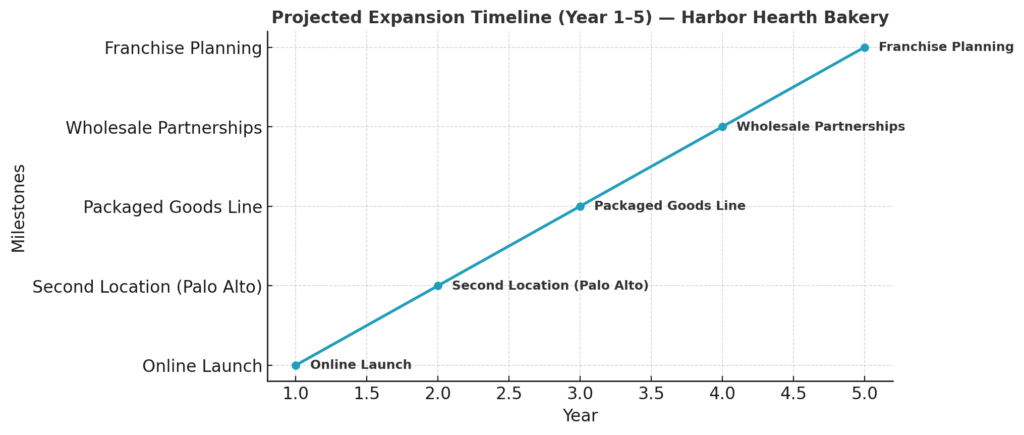
In Year 4, after achieving stable profit margins and loan repayment, Harbor Hearth Bakery will open a second location in Palo Alto. This area’s affluent and tech-driven demographic aligns perfectly with our brand profile. The second site will replicate our operational model with minor localization — maintaining consistency while adjusting to regional preferences.
The expansion budget is estimated at $275,000, funded through retained earnings and a potential SBA loan. Financial projections show the second location could reach break-even within 14 months, given the existing brand reputation and supplier network.
12.3 Phase 3: Product Line Diversification (Year 5 and Beyond)
- Launch branded packaged goods — Harbor Hearth Granola, Artisan Bread Mix, and seasonal cookie boxes for retail shelves.
- Develop wholesale partnerships with cafés, coworking spaces, and local hotels.
- Explore franchise licensing opportunities within California by Year 6.
Each growth step is measurable and scalable. Rather than expanding rapidly, the company will prioritize maintaining quality and consistency — the values that define the brand.
12.4 Long-Term Vision
By Year 7, Harbor Hearth aims to evolve from a single-location bakery into a recognized regional brand synonymous with transparency and craftsmanship. With strong cash flow, digital sales infrastructure, and a proven marketing engine, we plan to position ourselves for future investor partnerships or partial acquisition opportunities. This forward-thinking mindset makes our plan not just a sample bakery business plan but a roadmap for sustainable entrepreneurship in the food industry.
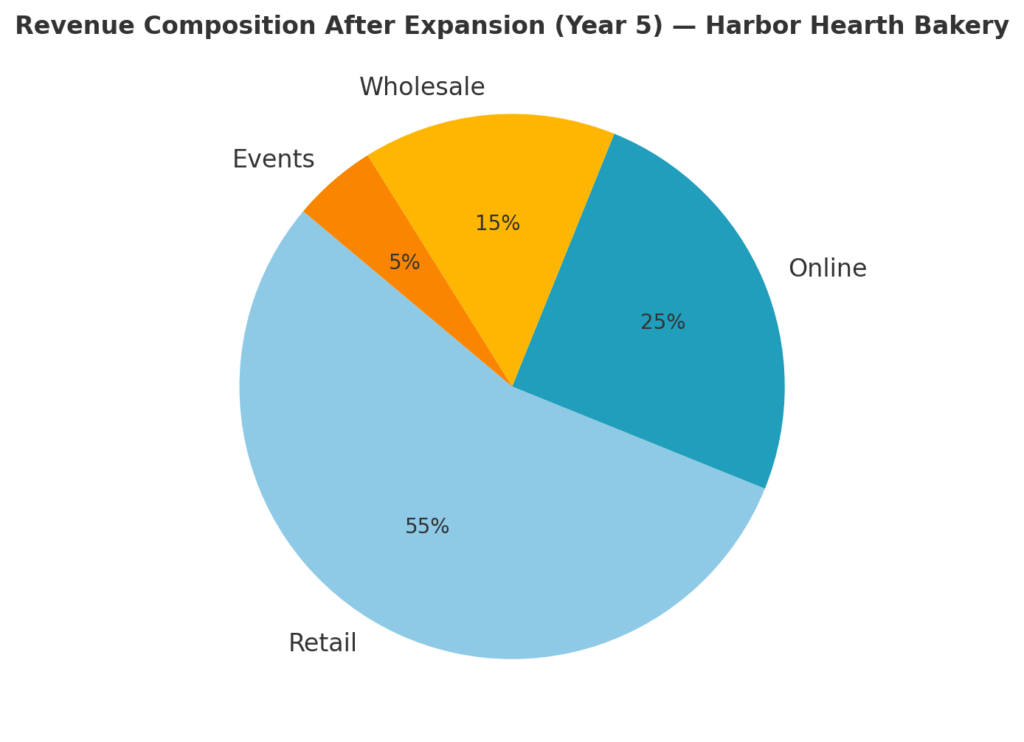
13. Appendix
The appendix includes all supporting materials and reference documents validating the data and projections in this business plan.
- Floor Plan Sketch: Layout of the 1,500 sq ft facility with production, retail, and seating zones.
- Equipment Quotes: Supplier estimates for ovens, mixers, espresso machines, and refrigeration units.
- Sample Menu Designs: Seasonal and core menu concepts with pricing and nutritional details.
- Management Team Résumés: Backgrounds of Emma Hartley, Luis Alvarez, and Julia Nguyen.
- Supplier Letters of Intent: Confirmations from Central Milling Co., Clover Sonoma, and Berkeley Bowl for ongoing supply agreements.

